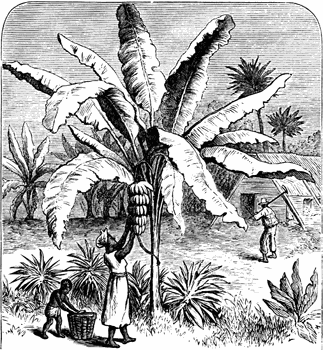Bananarama
August 3rd, 2011
This evening, I ventured forth from our garret in search of ice cream. It seems the type we wanted is no longer made, so I was forced to make a second choice. On a whim, I opted for chocolate covered frozen bananas instead.

An 1891 illustration of banana cultivation.
It wasn’t ice cream, but they were quite tasty and surprisingly refreshing. And they inspired me to look up this 1888 Good Housekeeping article extolling the virtues of this tropical fruit and encouraging housekeepers to introduce them to the family table.
BANANAS.
Of Large Food Value At Low Cost.
The banana has long been known as a tropical fruit in this country and counted among the luxuries of life, yet its more important use, that of a food, has received but little attention in modern times, though it was in common use for this purpose in the early part of the sixteenth century, and in tropical countries it takes the place of our cereals, forming a very important food. Its composition is about the same as the potato, and like that esculent it is an imperfect food by itself, but very valuable in combination with something more nitrogenous, such as lean meat or fish. Prof. Johnston says that in tropical America six and a half pounds of the fruit, or two pounds of the dry meal with a quarter of a pound of salt meat or fish form the daily allowance of a laborer. It is said to yield a larger supply of food than any other known vegetable, from a given amount of land, and according to Humboldt a space that would yield four hundred and sixty-two pounds of potatoes or thirty-eight pounds of wheat would produce four thousand pounds of bananas, which makes it a valuable crop to cultivate. After the tree bears one bunch of fruit it dies down and others spring up around it, but a single bunch weighs sometimes from seventy to eighty pounds, though the average quantity from a tree is but thirty to forty pounds. It is the bread of the tropics, for while unripe the fruit is filled with starch cells. In this state it is dried in the oven, when it tastes very much like bread and will keep a long time. When the fruit ripens the starch changes to sugar and it becomes sweet as we eat it. Some sages have thought the banana and not the apple caused Adam’s fall, poets even perpetuating it through ages, as for example, “Fruit like that Which grew in Paradise, the bait of Eve, Used by the tempter.”
A recent writer has said that “the banana, when ripened in the tropics, possesses the flavors of all other known fruits, and when fully ripe it fills the air with richest scents.” They have become a very important article of commerce, the imports of the banana having in a few years nearly trebled. Some years since a consignment of four thousand bunches was thought a large cargo, but now steamers are constructed to carry this fruit alone, and from eighteen to twenty thousand bunches is an ordinary load. Importing them in such quantities has tended to reduce their price and from selling at fifty cents to one dollar the dozen, they are now within the reach of the smallest purse and can be bought from twelve cents a dozen to twenty-five, the latter price being for large fine ones. As their cost is low, and their food value large, they should often appear on the table in various forms, so that we can increase the variety that gives zest to appetite, and yet makes the change that is so desirable to prevent one from feeling surfeited, from even too much of a good thing. They are good for breakfast or at dessert when they are ripe, in their natural state, or for a change in banana sponge, a salad, jelly, etc.
This post is dedicated to my dear friend K. E. M., aka Banana.
